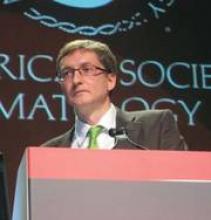ATLANTA – The broad use of prophylactic platelet transfusions in adults with hematologic malignancies and severe thrombocytopenia will likely be narrowed in the wake of the randomized, international TOPPS trial.
The primary endpoint of grade 2 or higher bleeding, by World Health Organization criteria, was seen in 50% with no prophylaxis (151 of 300) and 43% receiving a prophylactic platelet transfusion (128 of 298). The adjusted difference in proportions was 8.4%, which fell below the 15.2% upper limit for confidence interval set for TOPPS (Trial of Prophylactic Platelet Transfusions).
"This multicenter trial has not shown that a no-prophylaxis platelet transfusion policy is noninferior to prophylaxis," lead author Dr. Simon Stanworth said at the annual meeting of the American Society of Hematology.
A predefined subgroup analysis, however, found a significant difference in the primary endpoint between patients undergoing autologous stem cell transplantation (ASCT), who comprised 70% of the study population, and those receiving other treatments such as induction chemotherapy for acute myeloid leukemia (AML) or allogeneic bone marrow transplantation (P value = .04).
The rate of grade 2 or higher bleeding was very similar among patients undergoing autologous transplantation with or without prophylaxis (45% vs. 47%), while a clear benefit signal was seen in the subgroup of AML and allograft patients receiving treatment plus prophylaxis, compared with no prophylaxis (38% vs. 58%).
"Based on the results, the role of prophylactic platelet transfusions in different patient groups is varied and needs to be considered further," said Dr. Stanworth, a consultant hematologist with National Health Service Blood and Transplant, Oxford (England) University Hospital.
The finding that prophylactic platelets confer no advantage among those getting autologous transplants, however, could open up the opportunity to save millions of dollars in health care costs by skipping this unbeneficial treatment. An estimated 2 million platelets were transfused in the United States in 2008, a significant 16.7% increase from 2006, according to the latest National Blood Collection and Utilization Survey Report.
The results of TOPPS will likely change practice, but it will take time, Dr. Walter Dzik, codirector of the blood transfusion service at Massachusetts General Hospital, Boston, said in an interview.
"It takes quite some time, months to years, for knowledge transfer to occur and for well-established practices to change, but the end result will be to decrease the use of prophylactic platelets in autologous stem cell transplant patients," he said.
Prophylactic platelet transfusions are overused in the United States, in part because many clinicians transfuse their oncologic patients before they reach the recommended platelet prophylaxis threshold of 10 x 109 platelets per liter (Transfusion 2007;47:201-5). Thousands of doses of platelets are also used each year outside of the context of hematology/oncology, in patients undergoing surgery or cardiac procedures, without evidenced-based indications.
During his formal introduction of the plenary abstract, Dr. Dzik said a study published 2 years ago begs the question of whether prophylactic platelets are needed at all, reporting that the number of platelets in a prophylactic transfusion had no effect on the incidence of hemorrhage in patients with hypoproliferative thrombocytopenia (N. Engl. J. Med. 2010;362:600-13).
He pointed out that a recent open-label German trial, however, agrees with the TOPPS data, also finding no advantage from prophylactic platelets in autologous transplants, and all of the advantage resting in allogeneic transplants and AML patients. There was an "unmistakable" reduction in WHO grade 2 bleeding overall, but there was no advantage with the prophylaxis in the amount of red blood cells used per patient, number of days in the hospital, or overall survival (Lancet 2012;380:1309-16). It is against this background that clinicians looked to the TOPPS trial for additional insights, Dr. Dzik observed.
TOPPS enrolled 600 patients with a hematologic malignancy who were receiving or expected to receive chemotherapy or stem cell transplant, and expected to be thrombocytopenic for at least 5 days. Patients were randomly assigned to receive prophylactic platelet transfusion if their platelet count fell below 10x109/L, or no prophylaxis. Therapeutic platelets were given only after documented signs or symptoms of bleeding, prior to invasive procedures or at physician discretion.
Patients in the no-prophylaxis group were significantly less likely to receive a transfusion (59% vs. 89%), received fewer transfusions per patient (mean 1.7 vs. 3.0), and had more days with platelets less than 10,000/microL (mean 3.6 days vs. 1.8 days; all P less than .001, Dr. Stanworth reported.
Patients in the no-prophylaxis group averaged 1.7 days with a grade 2-4 bleed during follow-up vs. 1.2 days in the prophylaxis group (P value = .004), and developed an initial grade 2-4 bleed 2 days earlier than those receiving prophylaxis (hazard ratio 1.30; P = .02).


